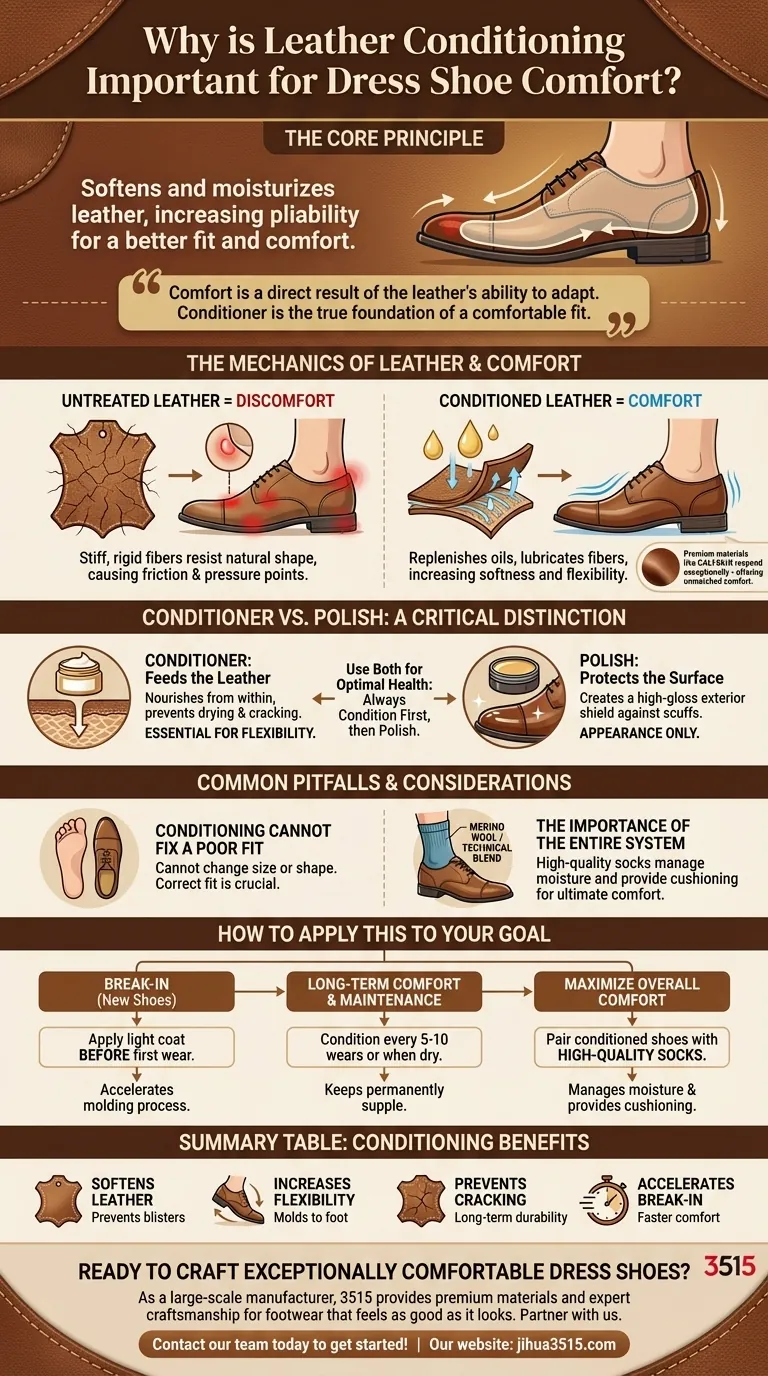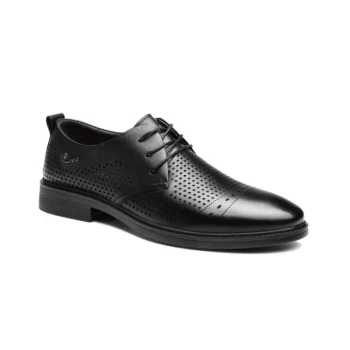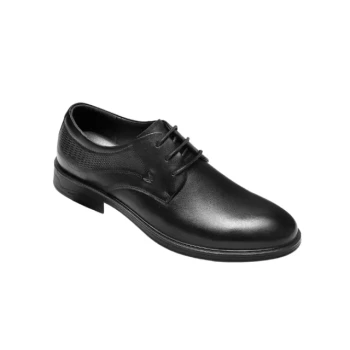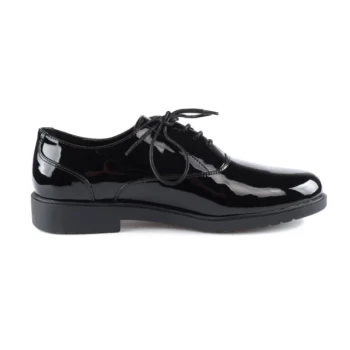To put it simply, leather conditioning is crucial for dress shoe comfort because it softens and moisturizes the leather, making it more flexible. This increased pliability allows the shoe to better conform to the unique shape of your foot, reducing pressure points and friction during the break-in period and beyond.
The core principle to understand is that comfort in a dress shoe is a direct result of the leather's ability to adapt. While polish addresses the shoe's appearance, conditioner addresses the material's health and flexibility, which is the true foundation of a comfortable fit.

The Mechanics of Leather and Comfort
To appreciate why conditioning works, you must first understand the nature of the material itself. Leather is a natural skin, and like your own skin, it requires moisture to remain pliable and healthy.
Why Untreated Leather Causes Discomfort
New or dry leather is often stiff. Its rigid fibers resist the natural shape and movement of your foot, creating friction and pressure points that lead to blisters and general discomfort.
This stiffness is the primary reason for the dreaded "break-in" period, as you are essentially forcing the inflexible material to bend to the will of your foot.
How Conditioner Transforms the Material
Leather conditioner is formulated with oils and emollients that penetrate the leather's pores. This process replenishes the natural fats that are lost over time due to exposure to air and moisture.
By restoring these essential oils, the conditioner lubricates the leather's internal fibers. This dramatically increases softness and flexibility, allowing the shoe to mold around your foot rather than fight against it.
The Role of High-Quality Materials
The type of leather is also a significant factor. Premium materials like calfskin are prized for their fine grain and inherent softness.
Because calfskin starts with a more supple and durable structure, it responds exceptionally well to conditioning. This synergy between high-quality material and proper care results in an unmatched level of comfort and elegance.
Conditioner vs. Polish: A Critical Distinction
Many owners confuse conditioning with polishing, but they serve entirely different functions. Understanding this difference is key to proper shoe care and comfort.
Conditioner Feeds the Leather
The sole purpose of a conditioner is to nourish the material from within. Think of it as a moisturizer that keeps the leather healthy, preventing it from drying out, cracking, and becoming stiff.
Polish Protects the Surface
Polish, on the other hand, works on the exterior. It creates a waxy layer that provides a high-gloss shine and a degree of protection against scuffs and water. It does nothing to improve the leather's flexibility.
Using Both in Tandem
For optimal shoe health, you should use both. Always apply conditioner first, allowing it to fully absorb and soften the leather. After it has dried, you can then apply polish to protect the surface and achieve your desired shine.
Common Pitfalls and Considerations
While conditioning is essential, it is not a cure-all. A successful approach to comfort requires a holistic view.
Conditioning Cannot Fix a Poor Fit
Conditioner can make a well-fitting shoe feel custom-molded, but it cannot fundamentally change the size or shape of a shoe. If the shoe is too narrow, short, or simply the wrong last for your foot, no amount of conditioner will fix the problem.
The Importance of the Entire System
Ultimate comfort isn't just about the shoe's leather. Factors like the quality of your socks play a significant role.
High-quality merino wool or technical-blend socks manage moisture, keep your feet dry, and provide cushioning, working in concert with the supple leather to create a comfortable environment for your feet.
How to Apply This to Your Goal
Your approach to conditioning should align with your specific objective.
- If your primary focus is breaking in new shoes: Apply a light coat of conditioner before the first wear to significantly soften the leather and accelerate the molding process.
- If your primary focus is long-term comfort and maintenance: Condition your shoes every 5-10 wears, or whenever the leather starts to feel dry, to keep them permanently supple.
- If your primary focus is maximizing overall comfort: Pair your properly conditioned, well-fitting shoes with high-quality socks designed to manage moisture and provide cushioning.
Ultimately, proactive care is the key to transforming your dress shoes from a necessity into a genuine pleasure to wear.
Summary Table:
| Conditioning Benefit | Impact on Comfort |
|---|---|
| Softens Leather | Reduces stiffness and friction, preventing blisters. |
| Increases Flexibility | Allows the shoe to mold to the unique shape of your foot. |
| Prevents Cracking | Maintains leather health for long-term comfort and durability. |
| Accelerates Break-In | Makes new shoes comfortable to wear much faster. |
Ready to Craft Exceptionally Comfortable Dress Shoes?
As a large-scale manufacturer, 3515 produces a comprehensive range of high-quality footwear for distributors, brand owners, and bulk clients. Our expertise ensures the leather in every pair is primed for optimal conditioning and comfort.
We can help you create shoes that feel as good as they look by providing:
- Premium Materials: Access to supple calfskin and other quality leathers that respond beautifully to conditioning.
- Expert Craftsmanship: Production capabilities that encompass all types of dress shoes and boots built for comfort from the ground up.
Let's discuss your next project. Partner with us to develop footwear that delivers unmatched comfort and quality to your customers.
Contact our team today to get started!
Visual Guide

Related Products
- Wholesale Comfort Leather Business Shoes with Dial Lacing System
- Classic Leather Derby Dress Shoes Wholesale & Custom Manufacturing
- Wholesale Leather Derby Shoes Manufacturer | Customizable Business & Dress Footwear
- Wholesale Leather Apron Toe Derby Shoes Custom Factory Production
- Wholesale Breathable Perforated Leather Derby Dress Shoes for Custom Brands
People Also Ask
- How can crocodile-inspired leather dress shoes make a statement at formal events? Command Attention with Bold Style
- What should be known about genuine leather for shoes? Don't Be Misled by the Label
- Are sneakers acceptable in a business casual workplace? How to Choose the Right Style
- How can one identify authentic leather footwear? A Guide to Spotting Genuine vs. Fake
- What are the key features of high-quality leather in shoes? Invest in Durability and a Perfect Fit



















